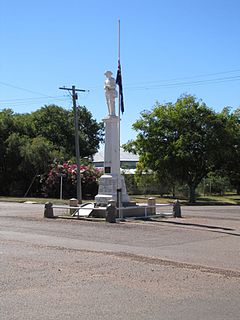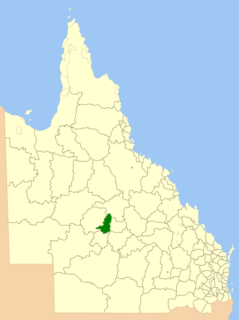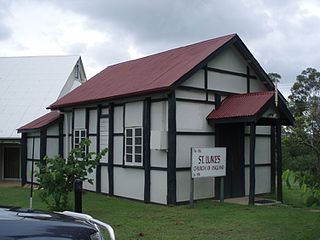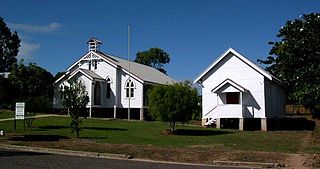
Barcaldine is a rural town and locality in the Barcaldine Region in Queensland, Australia. In the 2016 census, Barcaldine had a population of 1,422 people. This is the administrative centre of the Barcaldine Region. Barcaldine played a major role in the Australian labour movement.

Aramac is a rural town and locality in the Barcaldine Region, Queensland, Australia. In the 2016 census, Aramac had a population of 299 people.

The Diocese of Rockhampton is a diocese of the Anglican Church of Australia, founded in 1892. It is situated in the central part of the state of Queensland, Australia. It is part of the Province of Queensland. The cathedral church of the diocese is St Paul's Cathedral in Rockhampton.

The Shire of Ilfracombe was a local government area located in central western Queensland, between the towns of Longreach and Barcaldine. Administered from the town of Ilfracombe, it covered an area of 6,575.5 square kilometres (2,538.8 sq mi), and existed as a local government entity from 1902 until 2008, when it amalgamated with the Shires of Isisford and Longreach to form the Longreach Region.

George Dowglas Halford was the second Anglican Bishop of Rockhampton from 1909 until 1920.

St Paul's Anglican Cathedral is an Australian heritage-listed cathedral at 89 William Street, Rockhampton, Rockhampton Region, Queensland. It was designed principally by Annersley Voysey and built from 1883 to 1953. It is also known as St Paul's Church of England and St Paul's Church of England Cathedral. It was added to the Queensland Heritage Register on 21 October 1992. The associated hall and offices were listed on the Queensland Heritage Register on 23 June 2000.

St Mark's Anglican Church is a heritage-listed church at 55 Albion Street, Warwick, Southern Downs Region, Queensland, Australia. It is the second church of that name on that site. It was designed by Richard George Suter and built in 1868 by John McCulloch. It was added to the Queensland Heritage Register on 21 October 1992.

St John's Anglican Church is a heritage-listed church at 153 Cunningham Street, Dalby, Western Downs Region, Queensland, Australia. It is the third church of that name on the site and was designed by Henry James (Harry) Marks and built in the 1920s. It is also known as St John's Church of England. It was added to the Queensland Heritage Register on 14 August 2008.

St Agnes Anglican Church is a heritage-listed churchyard at Ipswich Street, Esk, Somerset Region, Queensland, Australia. It was designed by John Hingeston Buckeridge and built in 1889 by Lars Andersen. It is also known as St Agnes Rectory and Church Hall. It was added to the Queensland Heritage Register on 21 October 1992.

Christ Church Tingalpa and Burial Ground is a heritage-listed former Anglican church at 1341 Wynnum Road, Tingalpa, City of Brisbane, Queensland, Australia. It was built from 1868 to 1993. It is now known as the Pioneer Wedding Chapel. It was added to the Queensland Heritage Register on 2 February 1998.

The Bush Brotherhood was a group of Anglican religious orders providing itinerant priests to minister to sparsely-settled rural districts in Australia. They were described as a "band of men" who could "preach like Apostles" and "ride like cowboys".

Longreach railway station is the terminus station of the Central Western line, serving the town of Longreach, Longreach Region, Queensland, Australia. It is on the Capricorn Highway. It was built from 1887 to 1917. It was added to the Queensland Heritage Register on 12 December 2005.

St Luke's Anglican Church is a heritage-listed church at Sayre Crescent, Boyne Island, Gladstone Region, Queensland, Australia. It was designed by Arthur Malpas and built in 1924. It was added to the Queensland Heritage Register on 21 October 1992.

St Mary's Anglican Church is a State heritage-listed church at 11 Gordon Street, Mount Morgan, Rockhampton Region, Queensland, Australia. It was designed and built in 1888-1889 by Scottish-born Thomas Glen Cornes (1842-1903), superintendent of sawmills and carpenters at the Mount Morgan Gold Mining Company Limited. It was added to the Queensland Heritage Register on 25 August 2000.

St Mark's Anglican Church is a heritage-listed church at 36 Larnach Street, Allenstown, Rockhampton, Rockhampton Region, Queensland, Australia. It was built in 1900. It was added to the Queensland Heritage Register on 28 July 2000.

St John's Anglican Church is a heritage-listed church at 278 Ford Street, Berserker, Rockhampton, Rockhampton Region, Queensland, Australia. It was built in 1912. It was added to the Queensland Heritage Register on 5 August 2003.

Christ Church Anglican Church is a heritage-listed church at Cannon Street, St Lawrence, Isaac Region, Queensland, Australia. It was designed by Alfred Mowbray Hutton and built in 1898 by Newman Brothers. It was added to the Queensland Heritage Register on 27 October 2000.

St John's Anglican Church Precinct is a heritage-listed churchyard at 30-34 Macrossan Street, South Townsville, City of Townsville, Queensland, Australia. It was built from c. 1907 to c. 1911. It was added to the Queensland Heritage Register on 21 October 1992.

St Saviour's Anglican Church is a heritage-listed former church building at 26 Hynes Street, South Johnstone, Cassowary Coast Region, Queensland, Australia. It was built from 1938 to 1939 by Mose Romano. It was added to the Queensland Heritage Register on 24 September 2004.

St Michael and All Angels Church is a heritage-listed Anglican church at 2-6 Alford Street, Kingaroy, South Burnett Region, Queensland, Australia. It was designed by Colin Deighton and built in 1911. It was added to the Queensland Heritage Register on 17 September 2010.

























